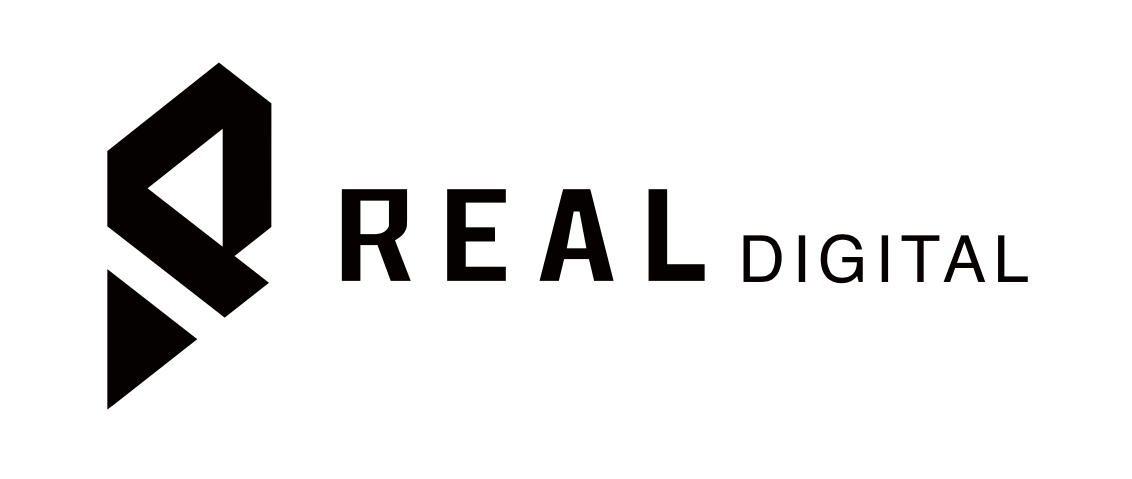Self Publishing On Amazon In 5 Easy Steps
Have you ever imagined your name appearing on a book cover? Get ready as we’re about to start on an exciting journey into self-publishing on Amazon! Say no more to the days of receiving countless rejection letters and holding out for someone else to approve your work! Self-publishing has become an acceptable option for authors who want greater control and exposure to their writing.
With Amazon’s influential self-publishing platform, aspiring writers and seasoned authors can overcome conventional publishing barriers and directly connect with readers worldwide. Understanding these procedures is crucial to avoid being taken off guard while attempting to publish your breakthrough book. Let’s examine the differences between Self-publishing and Traditional publishing so you can make the best choice possible.
| SELF-PUBLISHING | TRADITIONAL PUBLISHING | |
| FUNDS | You manage the funding for editing, designing, marketing, and more. (Self-publishing can be done without investing any money or even expensive if hiring outside help) | The publisher will provide the money to publish the book professionally. (However, getting a deal with a publisher is very hard.) You’ll also receive a monetary advance before the book is published. |
| OWNERSHIP | You’ll have complete ownership of both the rights and royalties. | You will not own any of your manuscript rights and will not have any control over how your book is marketed. |
| DECISIONS | No one can tell you what you can and cannot include. | Limited creative control over the contents of your books. |
| TIMING | It only takes 6 months to get to the market, but managing the entire selling process (not just writing the book) takes a very long time. | It takes around 2 years to make it to market, but there is a higher possibility that your book will be in bookstores and covered by the media. |
Self-publishing requires you to be the one in control. As a self-employed individual, your responsibilities increase, but as soon as you start selling, your royalty part also increases.
How Does Self-Publishing Work on Amazon?
Authors can easily publish their books on Amazon and sell them passively through a simple process called Amazon Kindle Direct Publishing. If authors choose to publish this way, they must prepare their text in a digital format that works with Amazon (such as DOCX, EPUB, or MOBI).
After that, authors can choose the kind of book they want to upload by logging into their Amazon KDP account and selecting appropriate categories. Both novice and experienced authors can publish their books on Amazon very quickly by following the procedures for self-publishing, which are covered in more detail later in this article.
The book will then be available on the Amazon Kindle store after, generally, 72 hours. The store has many self-published books, so Amazon offers promotional tools to assist authors in marketing their books. They can also decide to use Kindle book promotions, sign up for Kindle Unlimited, and use outside resources to get a head start over other authors and make sure as many Amazon Kindle customers see their book as possible.
How Much Time Does It Take to Get a Book Published on Amazon?
If you already have the completed work in EPUB format, the book cover selected, and any other required documents on your hands, publishing your novel ONLY requires an hour or so. Nevertheless, be aware that adding further self-publishing components, including A+ content, PPC advertisements, and social network advertisements, can make the entire process take several hours longer.
How To Self-Publish A Book On Amazon KDP Step by Step
1. CREATE AN AMAZON KDP ACCOUNT
First, go to kdp.amazon.com and create an Amazon KDP account. Once there, select “Sign Up” or “Sign In.”
If you already have a KDP account, you can use it to get into the KDP system and start working on your book. But if you don’t have one, you must create an account. To create a new KDP account, you must sign in to your Amazon account. It’s not your KDP account but the account you use to purchase items from Amazon. When you sign up with KDP, you will have to read and agree to their terms of use. Before accepting, make sure you comprehend what Amazon KDP is. After you have accepted, you will be able to view your Amazon Author dashboard. You can then combine the different parts of your book to produce a novel.
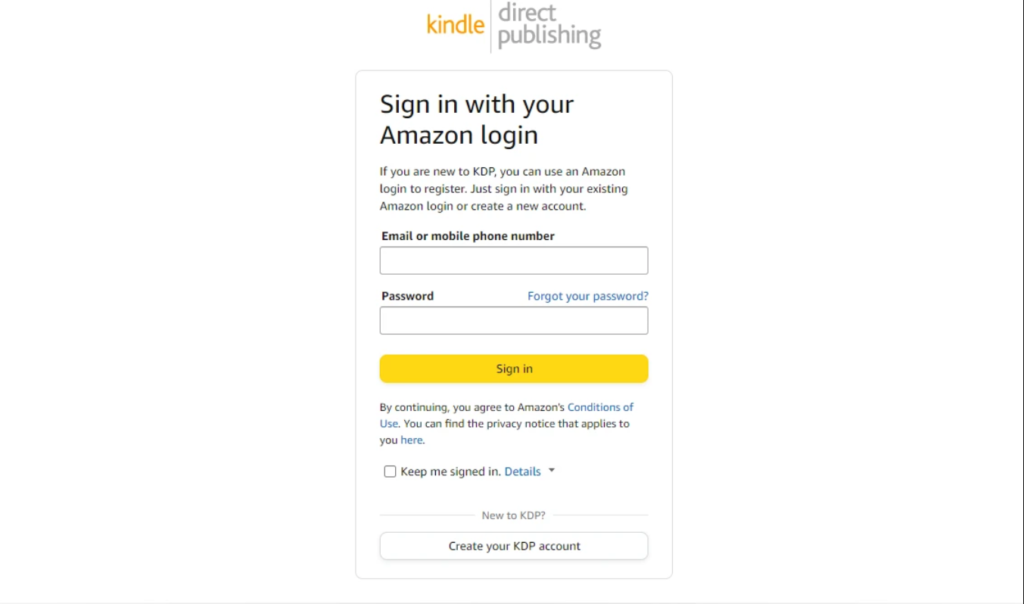
2. CREATE A NEW KINDLE EBOOK AND FILL OUT THE DETAILS
When you’re on the Amazon Author dashboard, click the “Kindle eBook” option to go to the page where you can add the novel’s text and technical details.
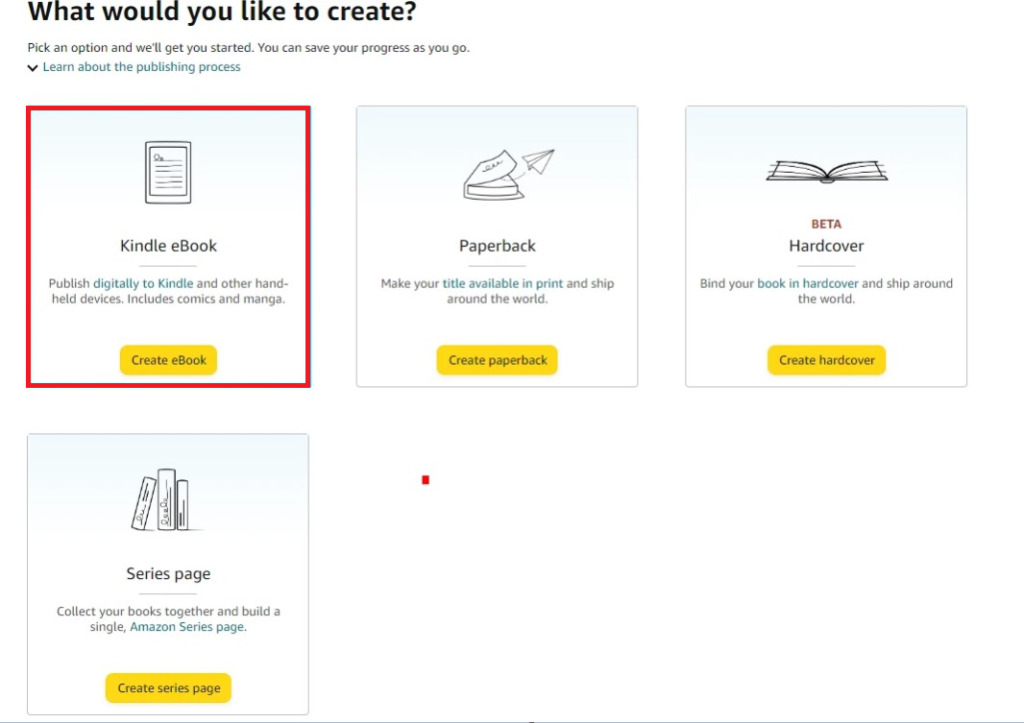
- CHOOSE YOUR LANGUAGE: The next step is to choose the language you want your book to be accessible. For the most part, as the author, this is your first language.

- ADD THE BOOK TITLE AND SUBTITLE: You must now add the title of your book and its subtitle (if there’s any). Ensure they catch the reader’s attention and spark their interest in the book’s plot.
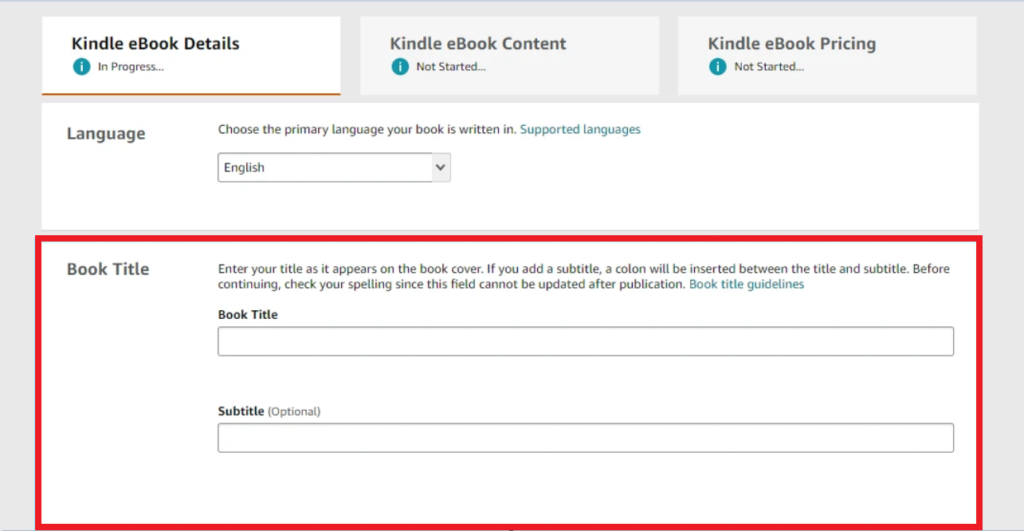
- ENTER YOUR NAME: Registering your name will make it appear on the cover of your book, which is another simple step. Note that if you would instead not use your real name, you are also permitted to use a pen name.
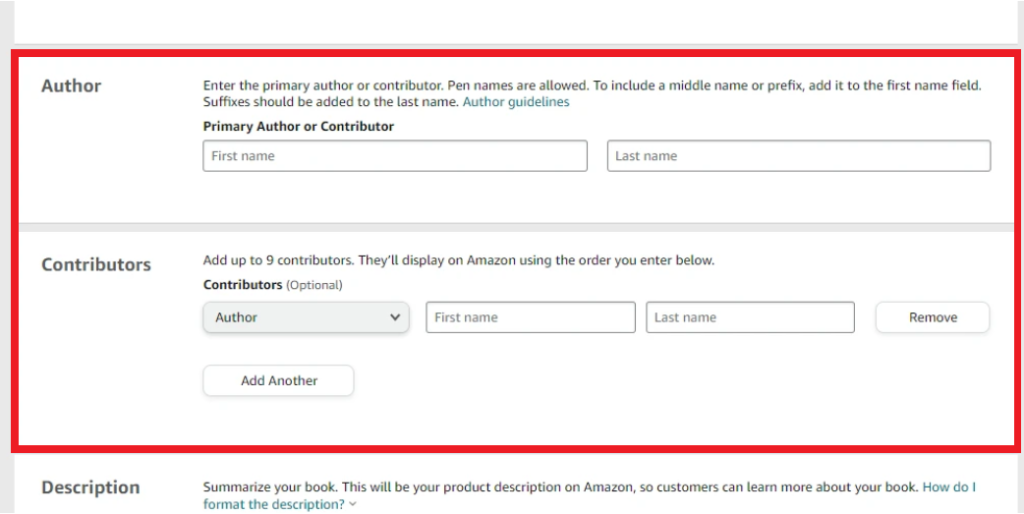
- CHECK THE RIGHTS OF PUBLICATION: You can select the relevant option below based on whether or not you have publishing rights. This section also features a helpful dropdown menu for those who need clarification about which option to choose.
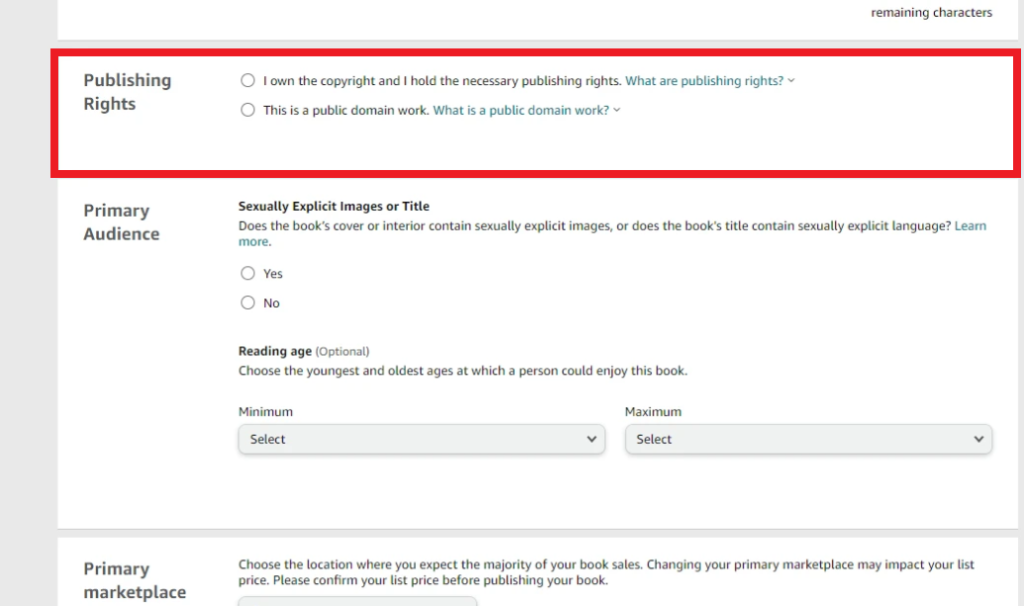
- SELECT THE KEYWORD: Choosing up to seven keywords that you plan to use to promote your book is a crucial step that will help it become visible on Amazon.
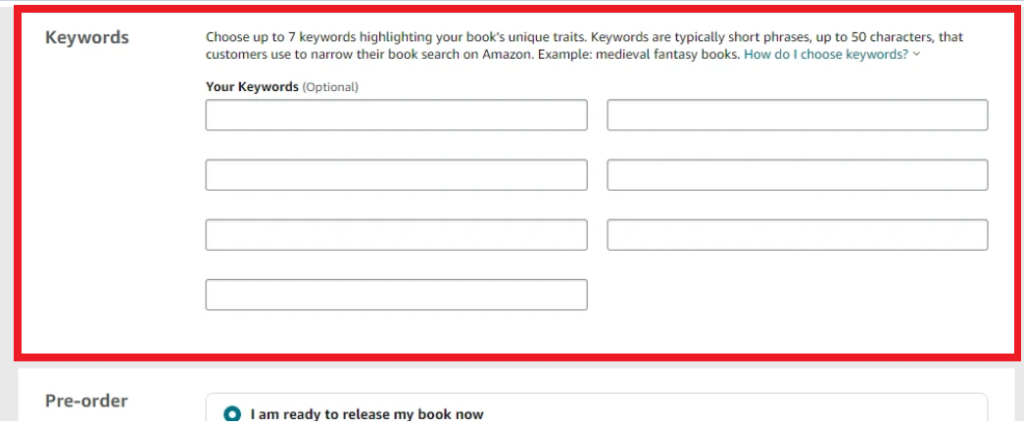
- SPECIFY THE BOOK CATEGORIES: Under this option, you can decide on up to three categories for your book. These categories should be carefully chosen based on the competition in every field and the subject matter of your book.
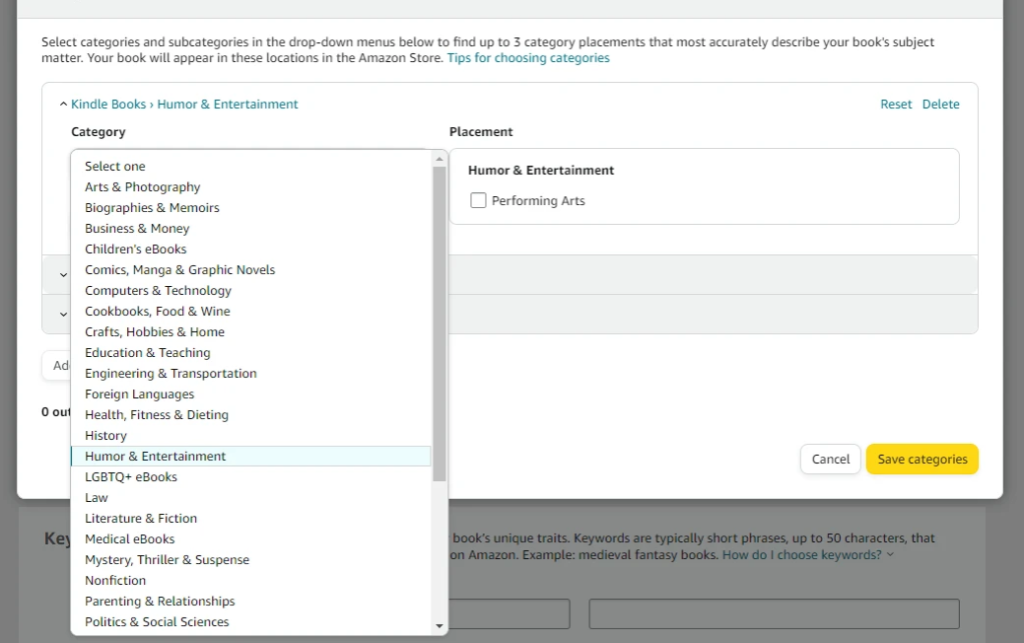
- DECIDE ON A RELEASE DATE: Selecting a release date for your new book may seem simple initially, but it’s an essential decision because the popularity of particular categories varies throughout the year. When deciding a release date that will help ensure the success of your book, be sure to check out previous books in the category you have chosen.

3. UPLOAD YOUR BOOK
- UPLOAD THE BOOK COPY: After completing the Kindle eBook details, you may now write the content! The first step in this section is to upload your completed manuscript. Although there are a few other file types (DOC/DOCX, KPF, and MOBI), we recommend proceeding with the EPUB file since it matches the requirements for KDP.

- UPLOAD THE BOOK COVER: The next step is uploading your book’s cover in a JPEG or TIFF file. There are several methods for creating a book cover. You could use the Cover Creator tool on Amazon KDP, which can be found in this section, or hire a graphic designer on freelance.com, upwork.com, or another website.

- EXAMINE AND PREVIEW THE BOOK: This step should re-check your Kindle eBook before releasing it to ensure its decent appearance to the global community. Pay attention to this stage, as it can also be an effective way to identify typos made at the last minute.

- ESTABLISH ISBN AND CHOOSE A PUBLISHER: Choosing the publisher and obtaining an ISBN will improve your book’s digital metadata, making it easier for Amazon to classify it. You can skip this step for now but remember to return to it whenever you’re ready.

- KDP SELECT ENROLLMENT: You may choose KDP Select if you seriously enjoy Amazon KDP and intend to sell your book through Amazon. This will provide you with extra marketing possibilities that will be very handy when releasing your book. You’ll earn more royalties, be seen by more Amazon customers, and take advantage of several exciting promotional opportunities.
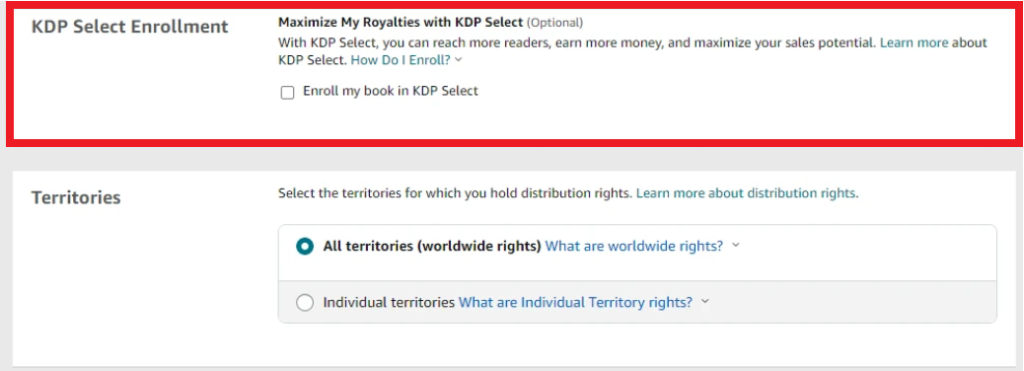
Nevertheless, KDP Select has some disadvantages, such as the fact that you can only sell your book through Amazon and will only receive a variable payment for it. It will be challenging to make a steady income, and you will generally lose control over some aspects of your book, which, for some authors, is a deal-breaker right away.
4. CHOOSE YOUR ROYALTY AND PRICING
In this step, you’ll have the option of a 35% or 70% royalty. The 70% option will pay you more for each book sold, but it comes with price restrictions and a different royalty calculation that might be more difficult to comprehend.
Likewise, choosing the 35% option will avoid having your royalties withheld to cover shipping costs. By charging less, you may reach a larger audience by drawing in readers who might not otherwise be able to afford more expensive works. The disadvantage of selecting the 35% option is that your royalty percentage will be smaller than the 70% one, and you will have to set the price of your book within a certain range.
On the other hand, if you choose the 70% option, your royalty percentage from sales will be higher, your pricing range will be more comprehensive ($2.99–$9.99), and your earning potential will be higher. Pros and cons: Authors who chose the 70% royalty option will have to contend with higher shipping expenses and territorial limits (i.e., their book will only be available in specific areas, leading to fewer sales).
Next, you’ll need to decide on the price you wish to sell the book for after determining your royalty rate. Remember that Amazon will decide on the proper pricing based on exchange rates, so you don’t need to worry about costs in markets outside of your own. But you can also set them up if you want.
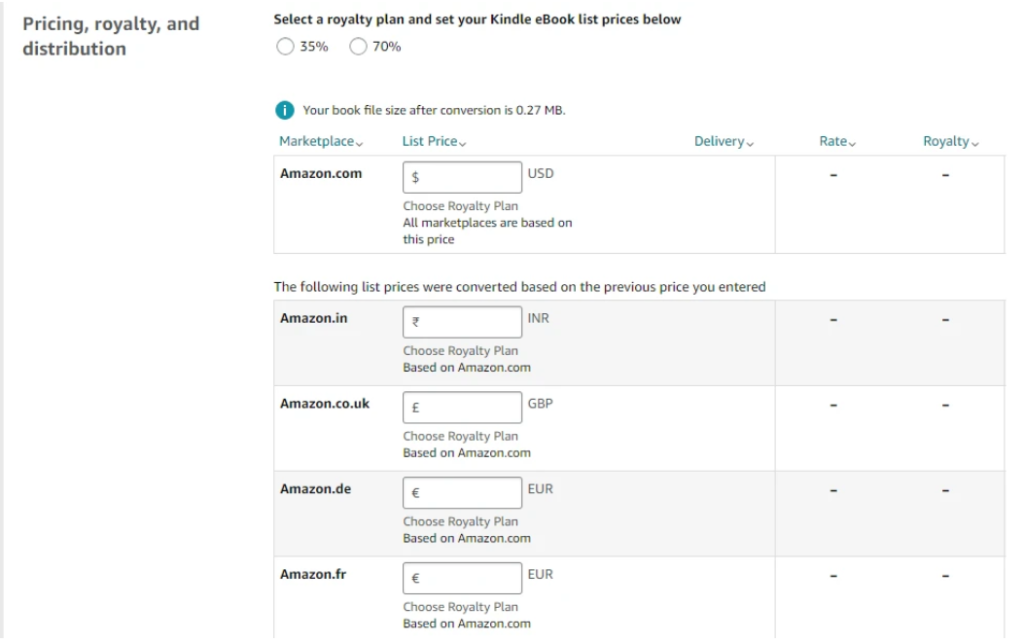
5. SAVE FOR DRAFT OR PUBLISH
Finally, the last step is to either publish your book immediately or keep the details as a draft that you may edit later. If you decide to publish your book immediately, be sure to assess the current market condition to determine whether now is the right moment to begin selling it.

Conclusion
In summary, self-publishing on Amazon gives authors more freedom and control than traditional publishing. It lets authors reach readers directly and keep more of their earnings. Although self-publishing requires authors to market their work and invest in editing and design, platforms like Amazon make it easier for anyone to share their stories with the world. Whether choosing self-publishing or traditional routes, authors today have more opportunities to share their work and connect with audiences.
Is Self-publishing worth it?
Kindle self-publishing can be worthwhile due to its control and independence, the potential for higher royalties, global reach through Amazon’s platform, low barrier to entry, and flexibility in publishing and updating content. However, success requires writing quality content and practical marketing efforts to stand out in a competitive marketplace. While Kindle self-publishing provides opportunities for authors, it’s essential to approach it with realistic expectations and a commitment to investing time and effort into writing, publishing, and promoting your book.
What are the most effective strategies for marketing and promoting a self-published book?
Effective marketing and promotion strategies for self-published books include building an author platform, optimizing book metadata, leveraging book reviews, offering free samples or excerpts, running promotions and discounts, utilizing email marketing, guest blogging, and author interviews, organizing virtual events, collaborating with other authors, and attending book fairs and events. These strategies aim to increase visibility, engage with readers, and drive sales by connecting directly with your target audience and leveraging various online and offline promotional channels.
What factors should self-published authors consider when setting the price for their books on Amazon?
When setting the price for their books on Amazon, self-published authors should consider several factors. They should conduct market research to understand competitive pricing, factor in production costs to ensure profitability and consider Amazon’s royalty rates. Authors should also consider reader perception, balancing pricing to communicate value without deterring buyers. Factors such as book-length and format, promotional goals, sales targets, and international pricing should also be considered to optimize sales and revenue on Amazon.
Book your Free Consultation with us, or get in touch here: [email protected]
